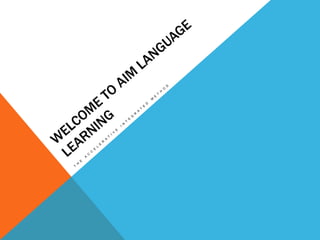
Welcome to aim language learning
- 1. WELCOME TO AIM LANGUAGE LEARNING The Accelerative Integrated Method
- 2. Introduction Wendy Maxwell the innovator The Ontario Institute for Studies in Education Drama in Education The Third International Conference on Drama in English Language Teaching – held in Tainan, Taiwan, 2008
- 3. AIM IS DRAMA AND STORY BASED Stories compel more than topics or themes The contexts and emotional elements supplied by stories encourages retention of language Language in AIM is corpus based: most frequent words are used first and then repeated often in a natural context Vocabulary is scaffolded: repeated often and reviewed and then more is added Grammar is introduced in a real world way: structures are offfered as needed for the story and practiced until the grammar is internalized (inductive method)
- 4. AIM Kinesthetic, VISUAL, and Aural learning Each word is associated with a gesture The gesture illustrates the meaning of the word This is sometimes linked to TPR (Total Physical Response) The class practices the pronunciation of the words as they gesture The words and gestures are taught in meaningful chunks
- 5. Gestures, Speech, image, chunking http://www.aimlanguagelearning.com/index.php/custom_pages/view_page/name/aimoverview
- 6. Vocabulary based on drama/story ALLOWS VOCABULARY TO BE EXPERIENCED IN DEPTH ALLOWS LANGUAGE TO BE MANIPULATED TO CREATE NEW SENTENCES AND EXPRESS IDEAS ALLOWS STUDENTS TO SPEAK MOST OF THE CLASS TIME ALLOWS THE CLASS TO BE CONDUCTED IN L2 FROM DAY ONE !!
- 7. THE PLAY CONSTRUCTS THE LANGUAGE AS STUDENTS MEMORIZE THE TEXT TO THE PLAY, THEY INTERNALIZE THE VOCABULARY, THE GRAMMAR, AND USE WHAT THEY HAVE LEARNED TO WORK TOGETHER STUDENTS LEARN LANGUAGE THROUGH PERFORMING RAPS, CREATING AND MOVING TO DANCE AND THE MOVEMENT PERFORMING THE PLAY GRAMMAR IS LEARNED THROUGH RAPS (GRAMMAR RAPS) MOVEMENT, GESTURE, SONG, EMOTION, AND MEANING PRODUCES MEANINGFUL L E A R N I N G
